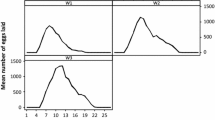Abstract
The method of estimation of the biological age in hungry tick females by revealing of the degree of lipid inclusions in the cells of the midgut and of the fat body is assumed. In order to estimate the degree of fat reserves in hungry females, live ticks were dissected and fragments of their internal organs were vitally stained with the saturated solution of Sudan III in 70% ethanol. Three age-specific groups were established, including (I) young females whose intestines and fat body were filled with fat inclusions; (II) mature females whose fat reserves were partially expended; and (III) old females possessing solitary fat inclusions in their midgut and fat body.
Similar content being viewed by others
References
Balashov, Yu.S., “Dynamics of Food Storage and Age Determination in Hungry Ixodid Ticks,” Zool. Zh. 40, 1354–1363 (1961).
Balashov, Yu.S., “Determination of the Physiological Age and Age Composition of Hungry Females of Ixodes ricinus and Ixodes persulcatus in Leningrad Province,” Med. Parazitol. 1, 47–55 (1962).
Balashov, Yu.S., Ixodid Ticks, Parasites and Vectors of Infections (Nauka, St. Petersburg, 1998) [in Russian].
Balashov, Yu.S., Parasitism of Acarines and Insects on Terrestrial Arthropods (Nauka, St. Petersburg, 2009) [in Russian].
Balashov, Yu.S., “The Role of the Population Structure of Ixodid Ticks (Ixodidae) in the Maintenance of the Natural Foci of Infections,” Zool. Zh. 89, 18–25 (2010).
Balashov, Yu.S., Grigoryeva, L. A., and Leonovich, S.A., “Estimation of the Biological Age in Females of the Taiga Tick Ixodes persulcatus by Changes in the Body Shape and the Surface of the Integument,” Parazitologiya 43, 433–436 (2009) [Entomol. Rev. 90 (2), 251–254 (2010)].
Grigoryeva, L.A., “Morpho-functional Changes in the Midgut of Ixodid Ticks (Acari: Ixodidae) During the Life Cycle,” Parazitologiya 43, 411–417 (2009) [Entomol. Rev. 90 (3), 405–410 (2010)].
Razumova, I.V., “Physiological Age of Adult Ixodid Ticks and a Quick Method of Its Estimation,” Med. Parazitol. 5, 557–566 (1977).
Razumova, I.V., “An Improved Method of Histological Determination of the Physiological Age in Ixodid Ticks (Ixodidae),” Parazitologiya 16, 209–218 (1982).
Razumova, I.V., “An Analytic Express-Method of Determination of the Physiological Age in Ticks of the Genus Ixodes,” Med. Parazitol. 6, 33–38 (1987).
Repkina, L.V., “Physiological Age,” in Taiga Tick Ixodes persulcatus Schulze (Acarina, Ixodidae): Morphology, Systematics, Ecology, Medical Significance, Ed. by N.A. Filippova (Leningrad, Nauka, 1985), pp. 232–238 [in Russian].
Taiga Tick Ixodes persulcatus Schulze (Acarina, Ixodidae): Morphology, Systematics, Ecology, Medical Significance, Ed. by N.A. Filippova (Leningrad, Nauka, 1985) [in Russian].
Pang, C.J., He, H., and Chen, G.., “Observation on Physiological Age of Dermacentor nuttalli in Altai District,” Acta Entomol. Sinica 30(1), 55–60 (1987).
Randolph, S.E., “Tick Ecology: Processes and Patterns Behind the Epidemiological Risk Posed by Ixodid Tick Vectors,” Parasitology 129, 37–65 (2004).
Steele, G.M. and Randolph, S.E., “An Experimental Evaluation of Conventional Control Measures against the Sheep Tick Ixodes ricinus. I. A Unimodal Seasonal Activity Pattern,” Bull. Entomol. Res. 75, 489–499 (1985).
Uspensky, I., “Physiological Age of Ixodid Ticks: Aspects of Its Determination and Application,” J. Med. Entomol. 32, 751–764 (1995).
Uspensky, I., Kovalevskii, Y.V., and Korenberg, E.I., “Physiological Age of Field-Collected Female Taiga Ticks, Ixodes persulcatus (Acari: Ixodidae), and Their Infection with Borrelia burgdorferi sensu lato,” Exp. Appl. Acarol. 38, 201–209 (2006).
Walker, A.R., “Age Structure of a Population of Ixodes ricinus (Acari: Ixodidae) in Relation to Its Seasonal Questing,” Bull. Entomol. Res. 91, 69–78 (2001).
Yeh, M.-T., Back, J.M., Hu, R., Nicholson, M.C., Kelly, C., Mather, T.N., “Determining the Duration of Ixodes scapularis Attachment to Tick-bite Victims,” J. Med. Entomol. 32, 853–858 (1995).
Author information
Authors and Affiliations
Corresponding author
Additional information
Original Russian Text © Yu.S. Balashov, L.A. Grigoryeva, 2010, published in Parazitologiya, 2010, Vol. 44, No. 4, pp. 289–296.
Rights and permissions
About this article
Cite this article
Balashov, Y.S., Grigoryeva, L.A. Estimation of the biological age in females of the taiga tick (Ixodes persulcatus: Ixodidae) by changing of fat resources in the organism. Entmol. Rev. 91, 388–395 (2011). https://doi.org/10.1134/S0013873811030146
Received:
Published:
Issue Date:
DOI: https://doi.org/10.1134/S0013873811030146



